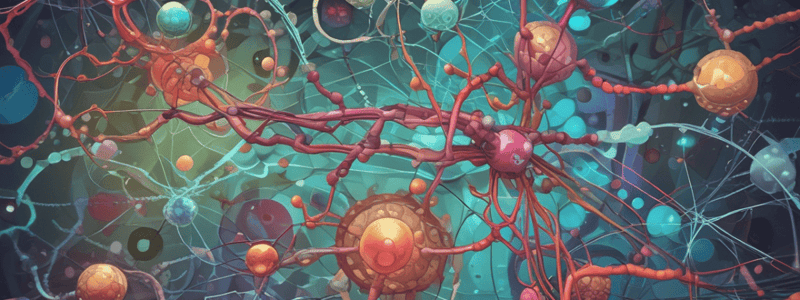Podcast
Questions and Answers
What was the primary conclusion Griffith made from his experiment with S-type and R-type bacteria?
What was the primary conclusion Griffith made from his experiment with S-type and R-type bacteria?
- Genetic information can be transferred between bacteria. (correct)
- R-type bacteria naturally turn pathogenic over time.
- Heat kills the disease-causing ability of all bacteria.
- Bacteria must be alive to cause disease.
Why did mice survive when injected with heat-killed S-type bacteria alone?
Why did mice survive when injected with heat-killed S-type bacteria alone?
- The poison from the bacteria was neutralized by heat.
- Heat creates an antibiotic effect in S-type bacteria.
- The heat-killed S-type bacteria were mutated to be non-pathogenic.
- Heat-killed bacteria do not retain disease-causing capabilities. (correct)
What did Griffith deduce as the factor responsible for transformation?
What did Griffith deduce as the factor responsible for transformation?
- A carbohydrate
- A lipid
- A gene (correct)
- A protein
What was the unexpected result Griffith observed when he injected mice with a mixture of heat-killed S-type bacteria and live R-type bacteria?
What was the unexpected result Griffith observed when he injected mice with a mixture of heat-killed S-type bacteria and live R-type bacteria?
What did Griffith find in the lungs of mice that died after being injected with the mixture of heat-killed S-type and live R-type bacteria?
What did Griffith find in the lungs of mice that died after being injected with the mixture of heat-killed S-type and live R-type bacteria?
Why did Griffith call the process he discovered 'transformation'?
Why did Griffith call the process he discovered 'transformation'?
What was Frederick Griffith investigating in 1928?
What was Frederick Griffith investigating in 1928?
What significance did Griffith attribute to the 'chemical compound' involved in transformation?
What significance did Griffith attribute to the 'chemical compound' involved in transformation?
What did Griffith's experiment ultimately suggest about the nature of genetic material?
What did Griffith's experiment ultimately suggest about the nature of genetic material?
Which type of bacteria caused pneumonia in Griffith's experiments?
Which type of bacteria caused pneumonia in Griffith's experiments?
What characteristic distinguished the S type bacteria from the R type in Griffith's experiments?
What characteristic distinguished the S type bacteria from the R type in Griffith's experiments?
What conclusion can be drawn from Griffith's experiments regarding the mice injected with harmless bacteria?
What conclusion can be drawn from Griffith's experiments regarding the mice injected with harmless bacteria?
What key question did biologists have about genetics a hundred years ago?
What key question did biologists have about genetics a hundred years ago?
In the context of heredity, what have scientists inferred about the role of DNA?
In the context of heredity, what have scientists inferred about the role of DNA?
Why were the appearances of bacterial colonies critical in Griffith's research?
Why were the appearances of bacterial colonies critical in Griffith's research?
According to the provided content, what was not a goal of Griffith’s experiments?
According to the provided content, what was not a goal of Griffith’s experiments?
Flashcards are hidden until you start studying
Study Notes
Identifying the Substance of the Gene
- Genes are made up of a chemical substance that carries genetic information, which determines the physical traits of an organism.
- Frederick Griffith's experiment in 1928 aimed to discover the chemical nature of the gene.
Bacterial Transformation
- Griffith isolated two types of bacteria: S-type (disease-causing) and R-type (harmless), distinguishable by their colony shapes on culture plates.
- Griffith's experiment involved injecting mice with various bacterial combinations to understand the cause of pneumonia.
- Heat-killed S-type bacteria did not cause pneumonia in mice, suggesting it was not a poison.
- Mixing heat-killed S-type bacteria with live R-type bacteria led to pneumonia in mice, indicating a chemical factor was transferred.
Transformation
- Griffith coined the term "transformation" to describe the process by which the chemical factor changed harmless bacteria into disease-causing ones.
- This experiment showed that genetic information can be transferred from one bacterial type to another.
- The transforming factor was concluded to be a gene, as the ability to cause disease was inherited by the offspring of the transformed bacteria.
Studying That Suits You
Use AI to generate personalized quizzes and flashcards to suit your learning preferences.




